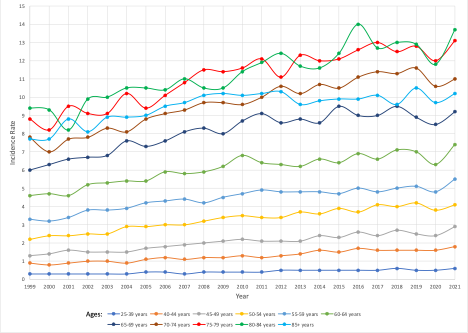Monday Poster Session
Category: Small Intestine
P4055 - Temporal Trends in Small Intestinal Cancer Incidence in the United States Over the Past 2 Decades: A CDC Wonder Database Analysis
Monday, October 27, 2025
10:30 AM - 4:00 PM PDT
Location: Exhibit Hall
- AP
Abhishek Patel, MD (he/him/his)
University of New Mexico
Albuquerque, NM
Presenting Author(s)
Abhishek Patel, MD, Ahmed Telbany, MD, Pooja Viswanath, DO, Evelyn Inga, MD, Gulshan Parasher, MD, FACG
University of New Mexico, Albuquerque, NM
Introduction: Small intestinal cancer (SIC) is a rare malignancy with increasing clinical significance due to its rising incidence and diagnostic challenges. Despite growing concerns about its prevalence, comprehensive analyses of long-term epidemiological trends remain limited. This study examined temporal trends in SIC incidence and mortality across demographic subgroups to better characterize the evolving burden of this disease.
Methods: We conducted a retrospective analysis using the CDC Wide-ranging Online Data for Epidemiologic Research (WONDER) Database from 1999 to 2021. The analysis used data stratified by age (11 groups from 25 to 85+ years), race (American Indian or Alaskan Native, Asian or Pacific Islander, Black or African American, and White), and gender. We calculated percentage changes in incidence and mortality rates and analyzed temporal trends across these demographic parameters.
Results: The overall incidence of SIC doubled during the study period, with the most pronounced increases in younger populations. Adults aged 45–49 years showed the highest relative increase (123%), followed by substantial increases in the 25–39 and 40–44 age groups (100% each). While older groups showed more modest increases (33–49%), they maintained the highest absolute incidence rates, with the 80–84 group reaching 13.7 per 100,000 in 2021 (Figure 1). Mortality trends showed age-dependent patterns, with stable or declining rates in those under 55 but significant increases in older adults, particularly the 55–59 and 85+ groups (50% increase in both). Black or African American populations consistently had the highest incidence and mortality rates (Table 1). Gender analysis revealed higher absolute rates in males, with comparable trends between genders.
Discussion: This analysis reveals a striking increase in SIC incidence over the past two decades, particularly among younger adults, suggesting a trend toward early-onset disease. The differential impact across age groups, with persistent racial disparities and age-dependent mortality, emphasizes the need for targeted interventions. These findings underscore the importance of enhanced surveillance, early detection, and further research to identify risk factors driving these trends, especially in younger and high-risk populations. Understanding these patterns is crucial for developing effective prevention strategies and improving outcomes.

Figure: Table 1: Age-Adjusted Incidence and Mortality Rates of Small Intestinal Cancer by Race/Ethnicity in the United States, 1999-2021

Figure: Figure 1: Age-Stratified Small Intestinal Cancer Incidence Rates in the United States, 1999-2021
Disclosures:
Abhishek Patel indicated no relevant financial relationships.
Ahmed Telbany indicated no relevant financial relationships.
Pooja Viswanath indicated no relevant financial relationships.
Evelyn Inga indicated no relevant financial relationships.
Gulshan Parasher indicated no relevant financial relationships.
Abhishek Patel, MD, Ahmed Telbany, MD, Pooja Viswanath, DO, Evelyn Inga, MD, Gulshan Parasher, MD, FACG. P4055 - Temporal Trends in Small Intestinal Cancer Incidence in the United States Over the Past 2 Decades: A CDC Wonder Database Analysis, ACG 2025 Annual Scientific Meeting Abstracts. Phoenix, AZ: American College of Gastroenterology.
University of New Mexico, Albuquerque, NM
Introduction: Small intestinal cancer (SIC) is a rare malignancy with increasing clinical significance due to its rising incidence and diagnostic challenges. Despite growing concerns about its prevalence, comprehensive analyses of long-term epidemiological trends remain limited. This study examined temporal trends in SIC incidence and mortality across demographic subgroups to better characterize the evolving burden of this disease.
Methods: We conducted a retrospective analysis using the CDC Wide-ranging Online Data for Epidemiologic Research (WONDER) Database from 1999 to 2021. The analysis used data stratified by age (11 groups from 25 to 85+ years), race (American Indian or Alaskan Native, Asian or Pacific Islander, Black or African American, and White), and gender. We calculated percentage changes in incidence and mortality rates and analyzed temporal trends across these demographic parameters.
Results: The overall incidence of SIC doubled during the study period, with the most pronounced increases in younger populations. Adults aged 45–49 years showed the highest relative increase (123%), followed by substantial increases in the 25–39 and 40–44 age groups (100% each). While older groups showed more modest increases (33–49%), they maintained the highest absolute incidence rates, with the 80–84 group reaching 13.7 per 100,000 in 2021 (Figure 1). Mortality trends showed age-dependent patterns, with stable or declining rates in those under 55 but significant increases in older adults, particularly the 55–59 and 85+ groups (50% increase in both). Black or African American populations consistently had the highest incidence and mortality rates (Table 1). Gender analysis revealed higher absolute rates in males, with comparable trends between genders.
Discussion: This analysis reveals a striking increase in SIC incidence over the past two decades, particularly among younger adults, suggesting a trend toward early-onset disease. The differential impact across age groups, with persistent racial disparities and age-dependent mortality, emphasizes the need for targeted interventions. These findings underscore the importance of enhanced surveillance, early detection, and further research to identify risk factors driving these trends, especially in younger and high-risk populations. Understanding these patterns is crucial for developing effective prevention strategies and improving outcomes.

Figure: Table 1: Age-Adjusted Incidence and Mortality Rates of Small Intestinal Cancer by Race/Ethnicity in the United States, 1999-2021

Figure: Figure 1: Age-Stratified Small Intestinal Cancer Incidence Rates in the United States, 1999-2021
Disclosures:
Abhishek Patel indicated no relevant financial relationships.
Ahmed Telbany indicated no relevant financial relationships.
Pooja Viswanath indicated no relevant financial relationships.
Evelyn Inga indicated no relevant financial relationships.
Gulshan Parasher indicated no relevant financial relationships.
Abhishek Patel, MD, Ahmed Telbany, MD, Pooja Viswanath, DO, Evelyn Inga, MD, Gulshan Parasher, MD, FACG. P4055 - Temporal Trends in Small Intestinal Cancer Incidence in the United States Over the Past 2 Decades: A CDC Wonder Database Analysis, ACG 2025 Annual Scientific Meeting Abstracts. Phoenix, AZ: American College of Gastroenterology.
